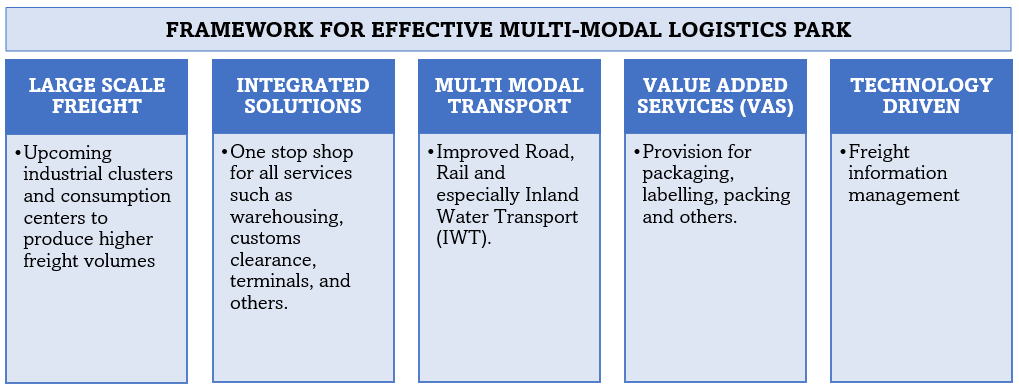What is a Multi-Modal Logistics Park
The logistics sector in India encounters several obstacles, such as inadequate infrastructure and increased operational expenses. The Indian government is moving in several directions to increase the effectiveness of the nation’s logistics. The creation of multi-modal logistics parks in key areas is one such endeavor.
According to official definitions, a Multi-Modal Logistics Park is a freight-handling facility that is at least 100 acres (40.5 hectares) in size, has multiple transport access points, automated warehouses, cold storage options, facilities for handling materials mechanically, intermodal transfer container terminals, bulk and break-bulk cargo terminals, and facilities for automated material handling. Value-added services like quarantine areas, testing facilities, bonded storage yards for customs clearance, and warehousing management services will also be offered by logistics parks. Additionally, provisions will be created for post-production manufacturing tasks such as final assembly and kitting, grading, sorting, labeling, packaging, reworking, and returns handling.
Since 2017, India’s logistics costs have been relatively high, accounting for 13% of the overall cost of goods compared to 8% in other major economies. The average cost of importing or exporting a container in India is 72% higher than in China. The MoRTH is building multi-modal logistics parks at specific places around the nation as part of its Logistics Efficiency Enhancement Program (LEEP) to lower these expenses and time and increase India’s competitiveness on the global stage.
To improve the freight logistics system in India, the government developed the Multi-Modal Logistics Park, which was overseen by National Highways Logistics Management Limited, previously known as the Cochin Port Road Company Limited, which is under the jurisdiction of the Ministry of Road Transport and Highways (MoRTH) and the National Highways Authority of India (NHAI). The main goal of the initiative included lowering overall costs and time spent, cutting warehouse costs, reducing vehicular pollution and congestion, and improving consignment tracking and traceability through the use of information technology, procedures, and infrastructure.
The first multi-modal logistics park in India is being built in Jogighopa, Assam. By the end of 2023, MMLP’s jetty should be completed. There will be great transportation links between this multimodal logistics park and the air, sea, and land. It will also have excellent amenities, including truck parking, refrigerated storage, warehouses, customs clearing, etc. It will provide amenities like a workshop, gas station, hotel, boarding options, etc., just like a Transport Nagar.
Also Read: Warehousing Sector: An Optimistic Outlook for India

Need for Multi-Modal Logistics Park
India’s logistics sector is expanding in line with the nation’s rapid economic growth. From 1,200 billion ton-kilometers in the fiscal year 2008 to over 2,300 billion ton-kilometers in the fiscal year 2015, the amount of freight transportation in the nation has doubled. Over the next ten years, the country’s freight transportation is expected to expand at an average pace of 8% to 10%, according to government predictions.
India relies largely on road transportation for freight transport, which is costly because of poor road conditions that result in shipment damage and traffic jams that prolong shipping times. Ports and railways are limited in capacity. Currently, logistics expenses account for 13–14% of the national GDP. The government intends to reduce it to 9% with the aid of programs like multi-modal logistics parks, Bharatmala, Sagarmala, the National Logistics Policy, etc.
Benefits of Multi-Modal Logistics Park
- Efficiency & Cost Savings: MMLPs facilitate the smooth transition of cargo between several modes of transportation, including road, rail, and water, which helps to streamline the movement of commodities. This can cut transportation costs and the time it takes for commodities to get to their destination, which is important for a country the size of India.
- Preventing Congestion: MMLPs can ease the strain on India’s already overcrowded road networks by encouraging the use of railroads and waterways. This can lessen traffic jams and lessen the deterioration of road infrastructure.
- Facilitating Trade: To effectively facilitate international trade, logistics parks need to be well-connected and efficient. They can facilitate customs clearance, assist with handling the import and export of commodities, and make it easier to transfer freight into and out of the nation.
- Encouraging Manufacturing and Industry: By offering an efficient and cost-effective logistics solution, these parks can draw in industrial and manufacturing activity. Businesses close to MMLPs stand to gain from less expensive transportation and easier access to markets.
- Backing the “Make in India” Initiative: The goal of India’s “Make in India” initiative is to encourage homegrown manufacturing. MMLPs can contribute significantly to this endeavor by offering a strong logistics framework that facilitates the transportation of domestically manufactured goods.
Framework for Effective MMLP

The creation of MMLPs is envisioned as a crucial policy tool to lower logistics expenses and assist in resolving three of the five previously mentioned restricting factors. These include, in particular, an inefficient fleet mix, an unfavorable modal mix, and an inadequate infrastructure for material handling. The Indian government authorized a plan to construct 35 MMLPs in July 2017. The land required for the projects will be provided by state governments, and public-private partnerships will then take over the area.
Government Initiative to Develop Multi-Modal Logistics Park
The government launched a number of initiatives to address the obstacles impeding the growth of the logistics industry. To overhaul the country’s integrated logistics sector, the Indian government is implementing reforms and adopting new technologies, along with the implementation of Make in India, a goods and services tax (GST), and infrastructure improvement projects. These initiatives include the following:
- Logistics division in the Ministry of Commerce and Industry: It was recently founded to coordinate the sector’s integrated development through the implementation of technology-based interventions, regulatory reforms, process improvements, and the identification of gaps and bottlenecks.
- Integrated logistics portal: To establish a connection between buyers, logistics service providers, and relevant governmental entities.
- Improved access to credit: Reclassification of the logistics industry as an Infrastructure sector subsector, opening up long-term funding options for the industry.
- Simplification of processes: The approval procedure for MMLP construction is streamlined, and the market accountability of the regulated sector would attract debt and pension funds to engage in approved logistics projects.
Future Locations for Developing the Multi-Modal Logistics Park
| Location | State |
| Vijayawada | Andhra Pradesh |
| Visakhapatnam | |
| Jogighopa | Assam |
| Patna | Bihar |
| Raipur | Chhattisgarh |
| Delhi-NCR | Delhi-NCR |
| Panaji | Goa |
| Kandla | Gujarat |
| Rajkot | |
| Surat | |
| Valsad | |
| Ambala | Haryana |
| Hisar | |
| Solan | Himachal Pradesh |
| Jammu | Jammu and Kashmir |
| Ranchi | Jharkhand |
| Bengaluru | Karnataka |
| Kochi | Kerala |
| Bhopal | Madhya Pradesh |
| Indore | |
| Bidkin | Maharashtra |
| Dighi | |
| Mumbai | |
| Nagpur | |
| Nashik | |
| Pune | |
| Sundergarh | Odisha |
| Bhatinda | Punjab |
| Sangrur | |
| Bikaner | Rajasthan |
| Jaipur | |
| Jodhpur | |
| Kota | |
| Chennai | Tamil Nadu |
| Coimbatore | |
| Tuticorin | |
| Hyderabad | Telangana |
| Udaipur | Tripura |
| Gorakhpur | Uttar Pradesh |
| Kanpur | |
| Haridwar | Uttarakhand |
| Kolkata | West Bengal |
| Siliguri |
